If you have a farm or an extra-large backyard, chances are, you have been thinking of raising certain animals to make the environment more lively and vibrant. Aside from chickens, most people will opt for easy-to-raise birds like ducks.
In the wild, these waterfowl can be found in many wet and coastal regions throughout the United States. But they are also one of the more highly-demanded poultry birds that are raised for different purposes. The main question is: how does one begin to raise these fun birds, be it as beginners or experienced breeders?
In this article, we will guide you on how to start raising your own ducks, step-by-step from determining the specific breed that suits you the best, to the do’s and don’t’s.
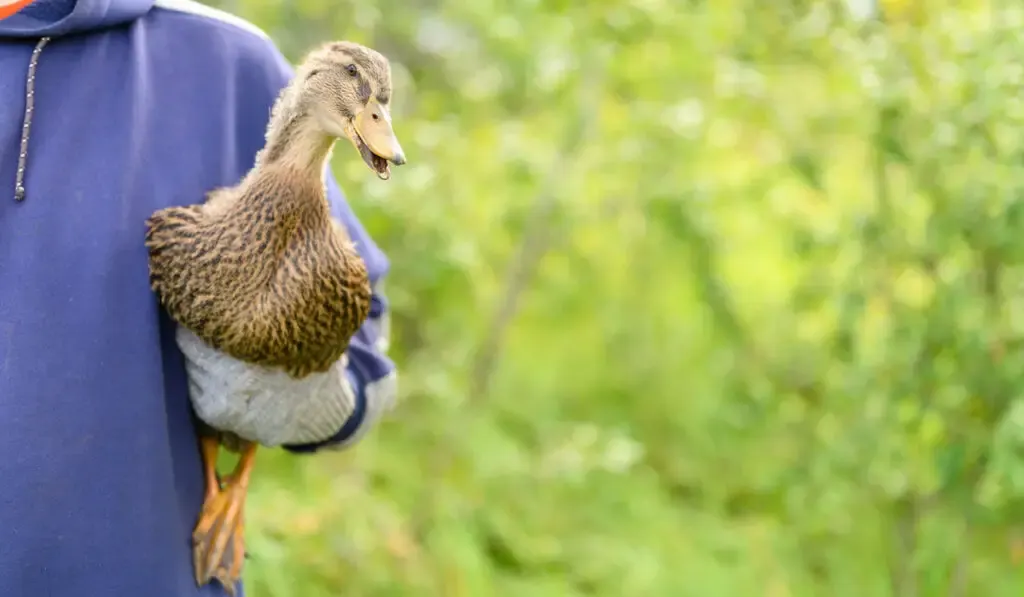
Selecting The Best Breed
Like other animals, you must first understand the laws and regulations of keeping or raising poultry. Local authorities might not care about keeping just one duck on your property, but if you want to raise a whole flock, be sure to check for any city or town ordinances that might be applicable.
Once you have cleared all these things, you are ready to select which breed appeals to your desire and needs.
There are generally two reasons why people raise ducks: eggs and meat production. Some dual-purpose breeds are also able to produce both eggs and high-quality meat.
This table shows some of the popular duck breeds that you can find out there, with each species categorized based on their purposes and availability:
| Duck Breeds | Weight | Purposes | Availability |
| Aylesburry | 8 to 10 lbs | Meat | Low availability |
| Ancona | 5 to 6.5 lbs | Meat and eggs | Some hatcheries |
| Buff Orpington | 5 to 6 lbs | Meat and eggs | Most hatcheries |
| Carolina Wood | 1 to 1.9 lbs | Eggs | Some hatcheries |
| Cayuga | 7 to 8 lbs | Meat and eggs | Most hatcheries |
| Golden 300 Hybrid | 4.5 to 5.75 lbs | Eggs | Some hatcheries |
| Indian Runner | 3.5 to 5.1 lbs | Eggs | Most hatcheries |
| Jumbo Pekin | 9 to 13 lbs | Meat | Most hatcheries |
| Khaki Campbell | 4 to 4.5 lbs | Eggs | Most hatcheries |
| Magpie | 4.5 to 5 lbs | Meat and eggs | Low availability |
| Mallard | 1.6 to 3.5 lbs | Meat and eggs | Some hatcheries |
| Muscovy | 6 to 15 lbs | Meat | Some hatcheries |
| Miniature Silver Appleyard | 1.9 to 2.4 lbs | Eggs | Most hatcheries |
| Pekin | 7 to 9 lbs | Meat and eggs | Most hatcheries |
| Rouen | 6 to 12 lbs | Meat | Most hatcheries |
| Saxony | 8 to 9 lbs | Meat and eggs | Some hatcheries |
| Silver Appleyard | 8 to 9 lbs | Meat and eggs | Some hatcheries |
| Blue/Black Swedish | 5.5 to 8.8 lbs | Meat | Most hatcheries |
| Welsh Harlequin | 4.5 to 5.5 lbs | Eggs | Most hatcheries |
Of all breeds listed above, there are a few that are considered bantam ducks. Most bantam ducks are raised for ornamental and exhibition purposes. But some of the special ones are prolific layers and able to produce many eggs per year.
Basic Duck Necessities
Once you have decided on a specific breed, it is time for you to buy ducklings of your desired breed. Buying ducklings can be better than incubating duck eggs. They cost less, are easy to maintain, and don’t require a lot of specialized equipment.
When you hand raise ducklings, you can instantly make a lasting bond with them. Get acquainted with them by spending time petting and being around these cute fuzzy babies. They will recognize and get used to your voice, and will easily follow you around. Older ducks are slightly stubborn and harder to handle.
You can buy ducklings at any local hatcheries nearby or by visiting well-known hatcheries’ websites such as:
- 1. Metzer Farms
- 2. Holderread Waterfowl Farm & Preservation Center
- 3. Moose Manor Farms
- 4. Murray McMurray Hatchery
Depending on where you live, these hatcheries will immediately ship ducklings after they hatch and you can expect them to arrive at your local post office within 24 to 48 hours.
When purchasing ducklings, the best time to buy them would be between the months of April and July. This is due to the period of warm months that is favored by ducks to lay eggs, which is in the spring and summer.
Once you bring the ducklings back home, they need a few basic necessities to live including:

· Housing
For ducklings, they need a brooder that can keep them warm and safe from any harm or harsh weather. A good brooder should be set up indoors, easy to clean, and with enough exposure to air and sunlight. Some of the things that you can use are boxes, a kiddie pool, and clean crates.
This brooder should also be surrounded by ¼ inches wire mesh that stands around 4 inches tall. Each duckling needs around half a square foot of space in the first two weeks. Then, you can slowly increase the space by at least one foot when they reach four weeks.
You should also change their bedding regularly to prevent any mess or humidity issues that can cause the build-up of mold and dirt.
Specifically, for the first three days, they prefer a temperature of 90 to 92 degrees. When they reach four to seven days, you can gradually reduce the temperature to around 85 to 90 degrees. After a week, you can reduce the temperature to around 5 degrees per week until they are fully mature.
You can also put an infra-heat lamp to create a warm targeted area where ducklings can sit and get the heat from this lamp. Be sure to check on their behavior to make sure that they don’t receive too much or too little heat inside the brooder.
Once they have grown into fully matured ducks, you can safely move them into another shelter or a coop. Unlike chickens, ducks are much bigger and they need a lot more wiggle room to move around and walk. They should have at least 10 to 20 square feet of space per individual.
This coop can also be built into a large pen that can accommodate more ducks to prevent overcrowding issues. Don’t forget to set up good ventilation. Odor and moisture buildup can cause diseases or worse, such as a massive viral infection that affects the entire flock.
For their bedding, you can use materials like straw or hay that don’t trap moisture and water.
Lastly, don’t forget to build fences around their houses. Most ducks can’t fly well and they rarely take off to a greater height. Aside from being an escape-proof structure, fences act as protective barriers that deter predators away from your ducks.
In addition, you can also put another layer of barbed wire outside the fences to make sure no predators can even get close. Make sure the locks on the entry doors of the coop are strong enough to protect your ducks from predators that are smart enough to flip or find their way around this system.
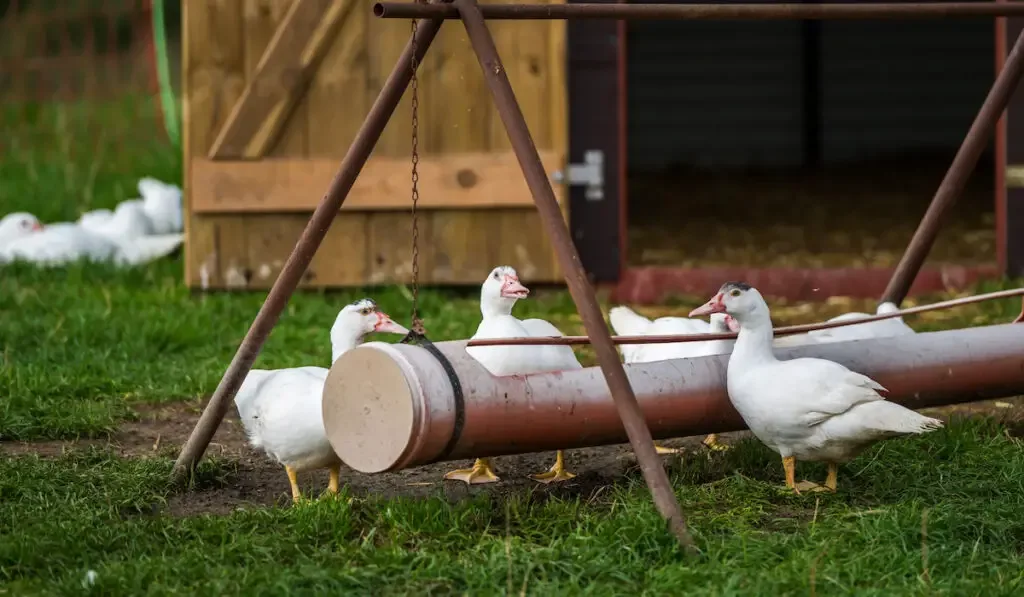
· Feed
Ducklings generally need a different type of diet than matured ducks. Their feed should have a higher amount of protein of around 20% to help them grow. During their first and second weeks, you can feed them with higher protein non-medicated flock starter feed or a duckling flock raiser.
Then, during their 3rd to 14th weeks, you can lower the amount of protein to between 15 to 16% by mixing 20% organic oats into their feed.
It is also important that you include a supplementary vitamin like niacin (vitamin B3) into their crumble. Niacin deficiency in ducklings can lead to poor bone development and leg deformities.
One way to supply them with enough niacin is by purchasing B-complex vitamins or Nutritional Yeast and sprinkling it onto their feed. Also, you should add a little water before mixing the feed with niacin to make sure that it is well-blended.
For adult ducks, they are able to forage independently for food. When you let them out in your backyard or farm, they will wander and scour for bugs, slugs, grubs, and weeds. Additionally, if you intend on feeding with a safe and healthy diet, you can provide pellets that contain around 15 to 16% protein.
Build feeders that are placed on an elevated place and fill them with pellets. Due to ducks’ eating behavior being messy, avoid using small plastic bowls that can easily be moved.
For laying ducks, you can bump the protein up to 16 or 17 % and provide pellets with 3.25% of calcium. Providing layer ducks with this balanced formula will ensure that they are able to produce high-quality eggs.
You can also incorporated grit (tiny rocks and sand) into their feed. Unless they can forage freely, ducks aren’t able to obtain grit from normal pellets. Grit is important to facilitate digestion and helps food grinding in their gizzard. Other beneficial foods that you can use as treats are fruits, vegetables, chopped nuts, and sunflower seeds.
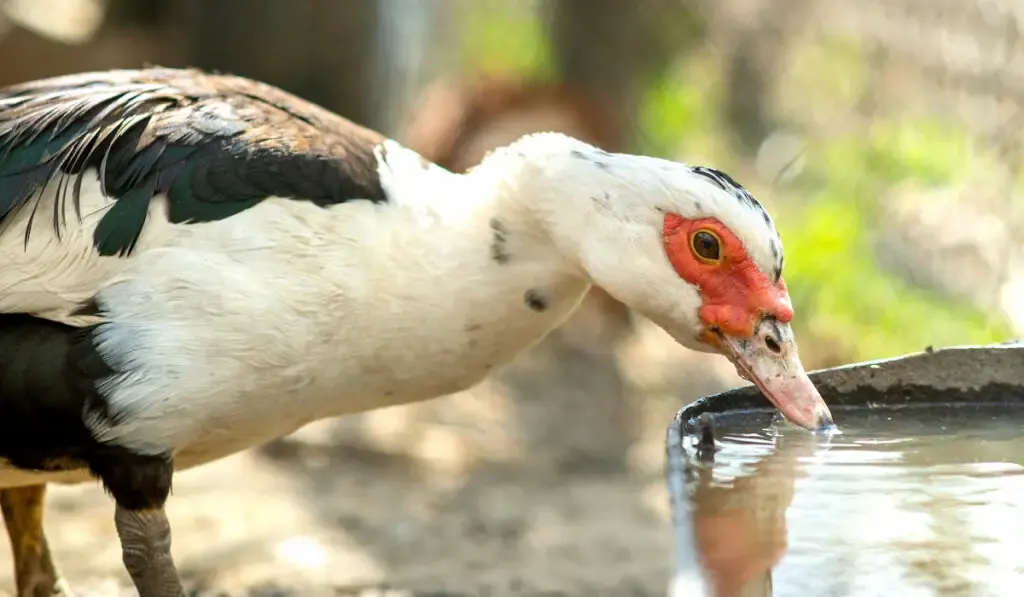
· Water
Ducks need a constant supply of water to keep them hydrated. To do this, you can place two poultry waterers near the coop. When they don’t get enough water, a choking problem can happen, especially when they eat. You can also use large jugs for every dozen ducks or ducklings.
Ducks should be able to dip their bills into the jugs to keep their mucus membranes moist. But the jugs shouldn’t be large enough that they are able to climb inside of them.
Aside from drinkings, ducks also need enough water for a bath or maintaining their body temperature during hot seasons. You don’t necessarily have to provide them with a pond or a small man-made lake. A kiddie pool is sufficient for them to swim and bathe.
Mature ducks possess oil glands at the base of their tails. Through swimming, they can learn how to activate these glands for repelling water from their feathers.

Health Issues To Be Aware Of
Ducks are generally hardy and resistant to many diseases. However, this doesn’t mean that their possibility of catching other illnesses is completely null. Mishaps and unexpected turns of events can occur and you have to be ready when they happen.
Here are some of the common health problems in ducks that you should know:
· Eye Infection
Eye infections in ducks are usually caused by poor hygiene. For instance, if their eyes are being exposed to unclean water, debris or bacteria will enter their eyes. Symptoms of eye infections in ducks can be recognized by redness or teary eyes, closed eyes, or bubbling eyes.
· Bumblefoot
Aside from chickens, ducks can also suffer from bumblefoot. This infection usually happens in the pad of ducks’ feet when your ducks step on any sharp objects, rocks, or rusty nails in their environment. This will lead to minor cuts or abrasions that will attract bacteria and other harmful microorganisms.
· Mycotoxicoses
Mycotoxicoses happen when ducks are exposed to mycotoxins from various molds including Fusarium, Aspergillus, and Penicillium. These molds grow in a wet environment can be found on straw or hay bedding, certain pasture grasses, or moldy food.
Mycotoxins are considered dangerous can cause many health problems in ducks including infertility, lesions, digestive problems, as well as immune system failures.
· Botulism
Botulism spores can enter your ducks’ bodies when they are exposed to stagnant water or pools in a dirty environment. Toxins from these spores can lead to serious health issues in ducks including paralysis of the neck, wings, and legs. Worst case scenario, they can fall into a coma-like state and die within two days.
· Fowl Pox
Also known as the avian fox, this highly contagious disease is transmitted through mosquito bites. Fowl pox could spread to other ducks when they share the same feeders and waterers or through mucus droplets of the infected ones.
Fowl pox can be categorized into two types: dry and wet. Dry fowl pox could cause the growth of warts on the duck’s body, both feathered and unfeathered parts. But they are easy to heal with the help of Neosporin type of ointment. On the other hand, wet fowl pox causes canker sores inside the duck’s throat, leading to breathing and eating problems.
· Colibacillosis
Colibacillosis is caused by the deadly E. coli bacterium that grows rapidly in a dirty environment or a poorly ventilated coop. Signs of avian colibacillosis can be recognized by reduced appetite, poor growth, and respiratory problems. Until today there is no treatment for this illness except for vaccinating mature ducks and keeping their coop clean.
· Worms
Roundworms are the most common parasite that can be found in ducks. To prevent this issue, you can sprinkle some diatomaceous earth onto ducks feed. You can also purchase commercially produced bird wormers at the nearby poultries or agricultural stores. These bird wormers could help kill both internal and external parasites in ducks.
· Aspergillosis
Aspergillosis is also known as ‘chicken pneumonia’. This deadly fungal infection happens when ducks are exposed to harmful mold and inhale the spores. Aspergillosis will cause respiratory problems in ducks. They will gurgle, choke, and gasp for air due to the spores that are filling up their lungs. Good hygiene, regular coop cleaning, and proper ventilation are some of the effective ways to combat this issue.
· Angel Wing
Also known as the ‘airplane wing’, this condition happens when your ducks eat certain foods that are high in protein and carbohydrates, especially in the early developmental stage of their wings. As a result, their wing will become distorted and the tip of their wing will become twisted.
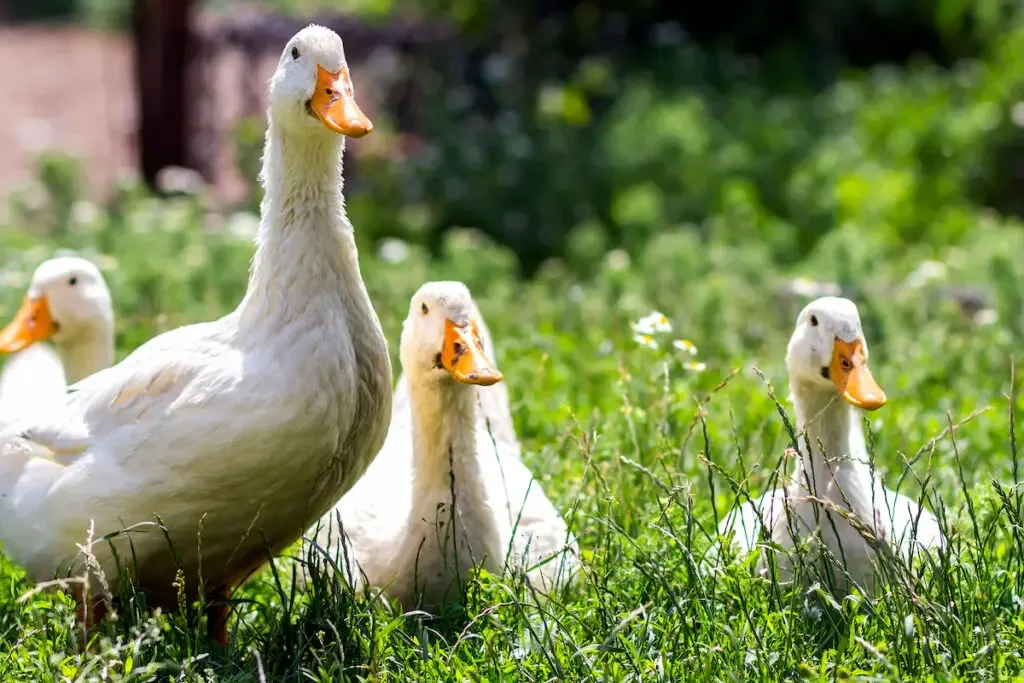
The Pros And Cons Of Raising Ducks
Raising ducks isn’t all rainbow and sunshine. Like other activities, there are benefits that you can gain and some drawbacks that you will have to face. Here are some advantages and disadvantages of raising these waterfowls:
The advantages of raising ducks:
- Ducks are easy to herd. Even if you don’t raise them from their young, luring ducks to move to another location is pretty straightforward. Some breeders will use directional panels with the help of work dogs to herd them to another location. Ducks will sense these changes and slowly, they will adapt to their new environment.
- Ducks are excellent foragers. Being left to wander freely in your farm or backyard, ducks will scour for anything edible ranging from bugs, slugs, crustaceans, to small plants and weeds. In any emergency cases, you don’t have to worry when you suddenly forget to feed them. Ducks are able to free-range safely without strict supervision.
- Ducklings are fast growers. They don’t need as much care as raising baby chicks. Due to this quality, you can expect to have a large flock of adult ducks in a short period of time.
- Ducks are great egg layers and meat producers. There will always be a constant demand for duck meats because they are primarily used in exotic Oriental cuisines in any restaurants that serve Asian foods. Furthermore, duck eggs can be stored for four months and longer without losing their quality and freshness. Hence, it is not a surprise why duck breeders will raise these birds for their eggs.
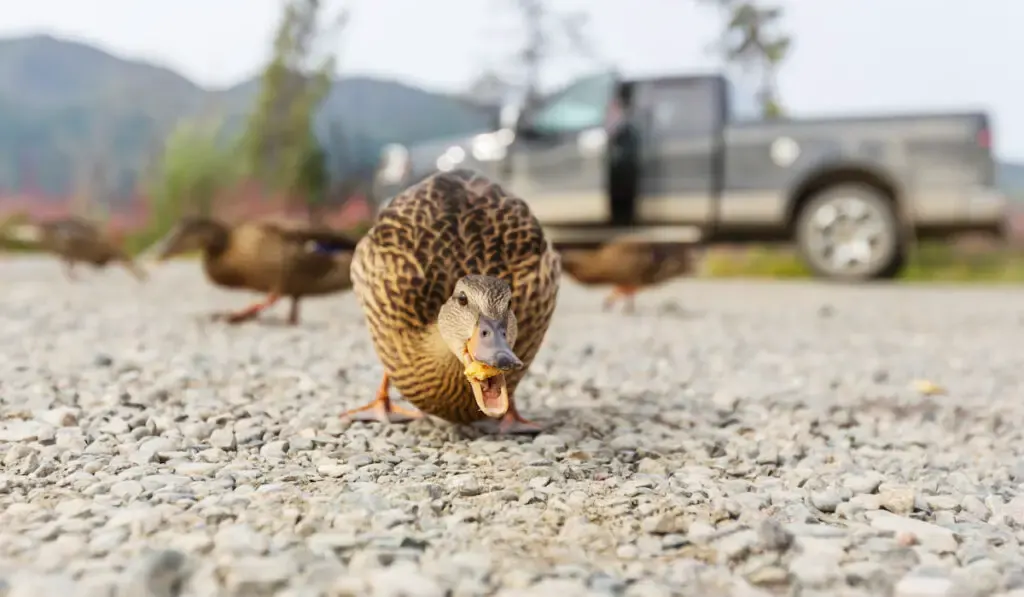
The disadvantages of raising ducks:
- Noise complaint. Everybody knows that you can hear ducks quacking even from afar. Hence, you have to be prepared to receive noise complaints, especially if your property is located in a very closed neighborhood or housing area.
- Ducks are messy creatures. Their water supply will always become muddy or dirty. Hence, keeping their water fresh and cleaning their coop will become your daily chore. When they drink, they will also dip in their head and bills into the water jugs or waterers. Combined with the wet environment that they create from messy drinking habits, you can imagine what an entire flock of eight to ten ducks will do when they behave the same way.
- Plucking their feather takes a lot of time. After you have slaughtered meat ducks and they are ready to be processed, you will have to spend a lot of time plucking their deeply embedded feathers. Giant breeds that have thick undercoats will also take a lot of time compared to light-feathered ducks.
Final Thoughts
No matter which breed you choose, you can successfully raise these birds as long as they get all their basic necessities. Even if you don’t have any experience dealing with a large flock of animals, ducks can be great starter animals due to their adaptability and easiness to mingle with their owners. With proper care, raising ducks is one of the best past-time activities that can be turned into a large-scale business!
Citations
- https://backyardpoultry.iamcountryside.com/freeguide/how-to-raise-ducks/
- https://www.timbercreekfarmer.com/best-tips-for-raising-ducks/
- https://www.farmaid.org/homegrown-101/homegrown-101-raising-ducks/
- https://www.tyrantfarms.com/how-to-raise-ducklings-a-step-by-step-guide/
- https://bestfarmanimals.com/how-to-raise-ducks-the-complete-guide-for-beginners/
- https://morningchores.com/raising-ducks/
- https://homeinthefingerlakes.com/beginners-guide-to-ducklings/
- https://pethelpful.com/farm-pets/A-Beginners-Guide-to-Raising-Ducks
- https://www.thehappychickencoop.com/raising-ducks-for-beginners/
